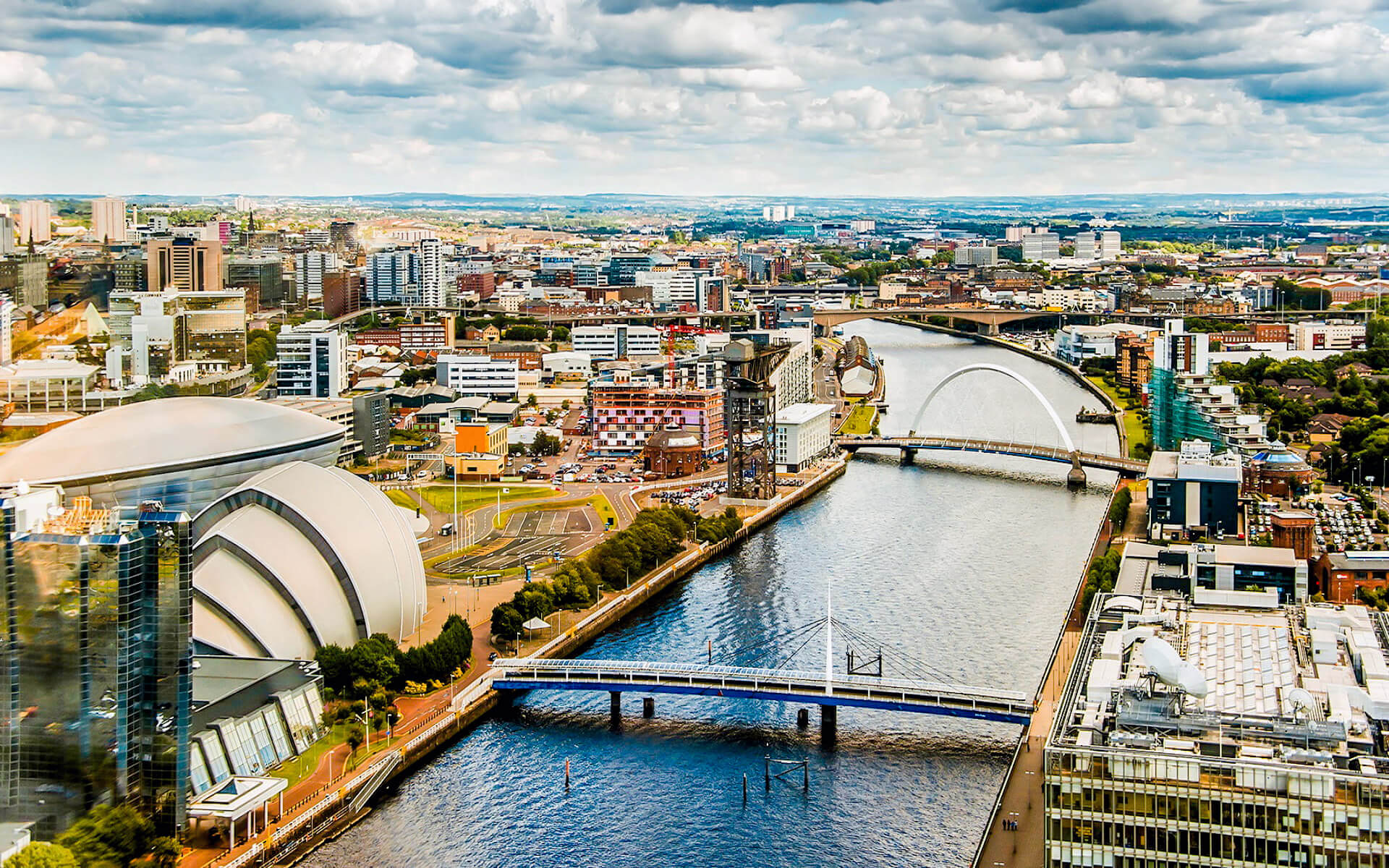Glasgow (Gaelic: Glaschu) is Scotland’s largest city, with a population of over 600,000 in the city itself and over 2 million if the Clydeside conurbation’s neighboring towns are included. Glasgow’s historical role as Scotland’s principal industrial city has been challenged by decades of change and different redevelopment initiatives. It is located at the west end of Scotland’s Central Belt on the banks of the River Clyde. Outside of London, it is the third most populous city in the United Kingdom and one of the country’s most important economic centers.
Glasgow has received the European titles of City of Culture (1990), City of Architecture and Design (1999), and Capital of Sport (in recent years) (2003). When Glasgow was declared a UNESCO City of Music in 2008, it became the second Scottish city to join the UNESCO Creative Cities project. Glasgow identified an average of 130 music events every week when drafting its proposal, ranging from pop and rock to Celtic music and opera. From being Britain’s once-mighty industrial powerhouse to a center for trade, tourism, and culture, the city has seen a transformation. Glasgow hosted the 2014 Commonwealth Games, which were a huge success.
Glasgow has grown to become one of the most popular tourist destinations in the British Isles, with a revitalized city center, unquestionably the greatest shopping outside of London, superb parks and museums (the most of which are free), and easy access to the Scottish Highlands and Islands.
The City Centre, which contains the majority of tourist attractions and much of the city’s shopping and entertainment, as well as its commercial heart, and the West End, the bohemian area of cafés, restaurants, and bars surrounding the University of Glasgow and Kelvingrove Museum, are the two main areas for visitors to central Glasgow. Climbing the various “drumlins” (hills) upon which the core area is constructed is the greatest method to gain nice views of the city.
The East End, located east of the City Centre and centered on Gallowgate and London Road, is located outside of downtown Glasgow. The region south of the River Clyde is known as the South Side, whereas the area north of downtown Glasgow is known as the North Side. An ancient industrial region west of the City Centre, along the banks of the River Clyde, is undergoing rehabilitation and has several new and magnificent buildings, including the Clyde Auditorium, the Science Centre, and the Riverside Museum.
CENTER OF THE CITY
The M8 motorway to the north and west, High Street to the east, and the River Clyde to the south define the City Centre (also called as “town” or “the toon” by locals). The grid arrangement of streets, as well as the ornate Victorian and Edwardian structures and civic squares that give the city much of its flavor, are the areas where most tourists will begin. Argyle Street and Sauchiehall Street, both on an east-west axis, are the city’s primary thoroughfares. Buchanan Street, which runs north-south, connects them. These three streets together make up the primary retail thoroughfares.
Merchant City, on the eastern side of the City Centre, features Glasgow’s original medieval core, which is centered on the Glasgow Cross (the junction of Trongate, Saltmarket, High Street, Gallowgate and London Road). Merchant City stretches all the way up to George Square, with many elegant buildings dating back to Glasgow’s industrial heyday. The principal artery of Old Glasgow, High Street, runs north of the Glasgow Cross and climbs upwards to the Glasgow Cathedral and the Necropolis cemetery.
Blythswood Hill, which is centered on Blythswood Square, dominates the western part of the City Centre, which comprises the city’s primary commercial and business hub. Bath Street, which runs parallel to Sauchiehall Street and features a diverse mix of small businesses and pubs as well as unique Georgian town house architecture, is the major gateway into the neighborhood. The city’s financial area is located south of Blythswood Hill, and it has several contemporary glass and steel office buildings alongside their classical predecessors. The district of Anderston, on the north bank of the River Clyde, was previously a dockland area, severely scarred by the city’s industrial collapse and the 1960s urban regeneration programs, but is currently being regenerated as a residential and business area.
WEST END
The M8 motorway to the east, Great Western Road to the north, the River Clyde to the south, and Crow Road to the west define the West End boundary line, which is roughly defined as being bounded by the M8 motorway to the east, Great Western Road to the north, the River Clyde to the south, and Crow Road to the west. The neo-Gothic University of Glasgow, which functions as an anchor for this bohemian sector, with its wonderful architecture, tree-lined lanes, and small commercial districts, is clearly the core of the region.
Argyle Street/Dumbarton Road is the major east-west thoroughfare, while Byres Road is the main north-south road, with a variety of independent businesses, pubs, and restaurants. Ashton Lane is a cobbled backstreet with characteristic whitewashed houses that links Byres Road to the University campus and has an unusual mix of restaurants and cafes that make it a tourist destination (be careful as the Lane can be a bit of a tourist trap during the summer months when the students of the university are not there to keep the bar prices reasonable). Kelvingrove Park is located to the east of the university campus and just downhill, with the tree-lined Kelvin Way serving as the park’s primary thoroughfare, connecting to Argyle Street near the Kelvingrove Museum.
- Visit Scotland Tourist Information, 10 Sauchiehall Street, G2 3GF, +44 845 859 1006. Mon-Sat 09:00-18:00, Sun 10:00-17:00.


